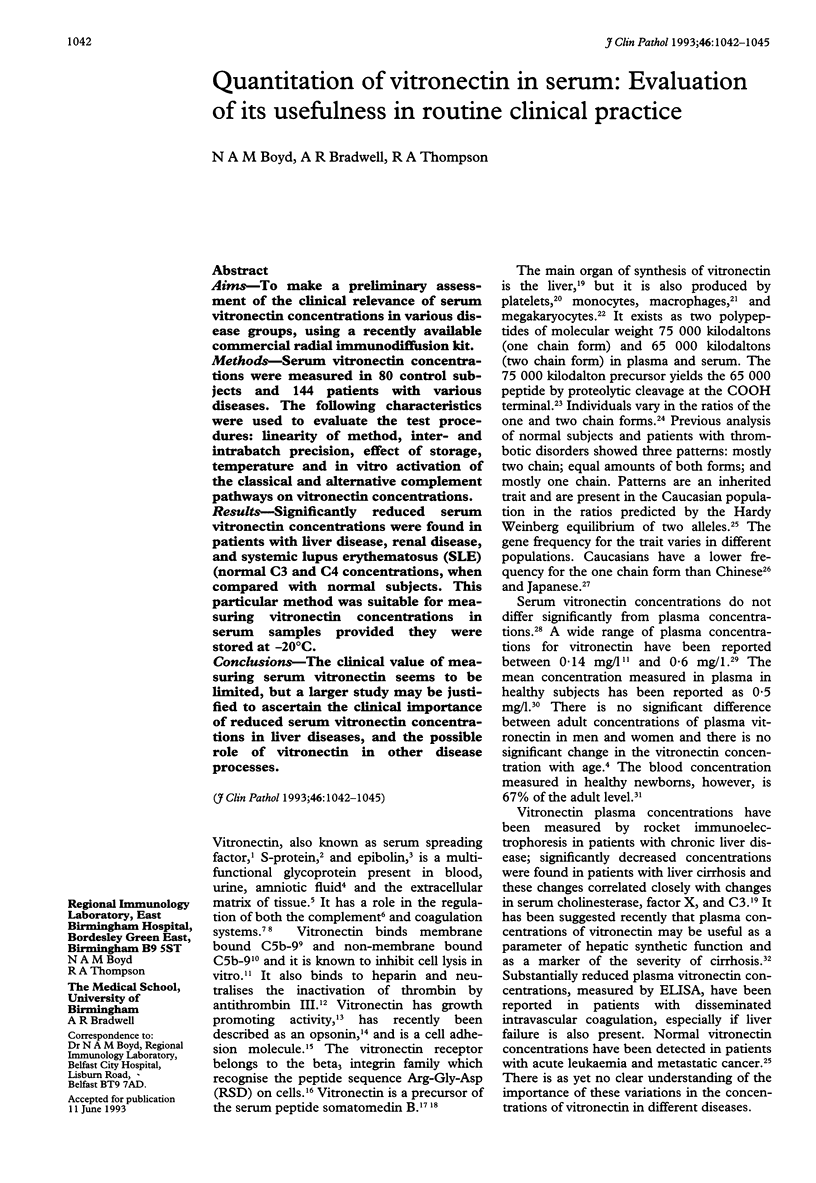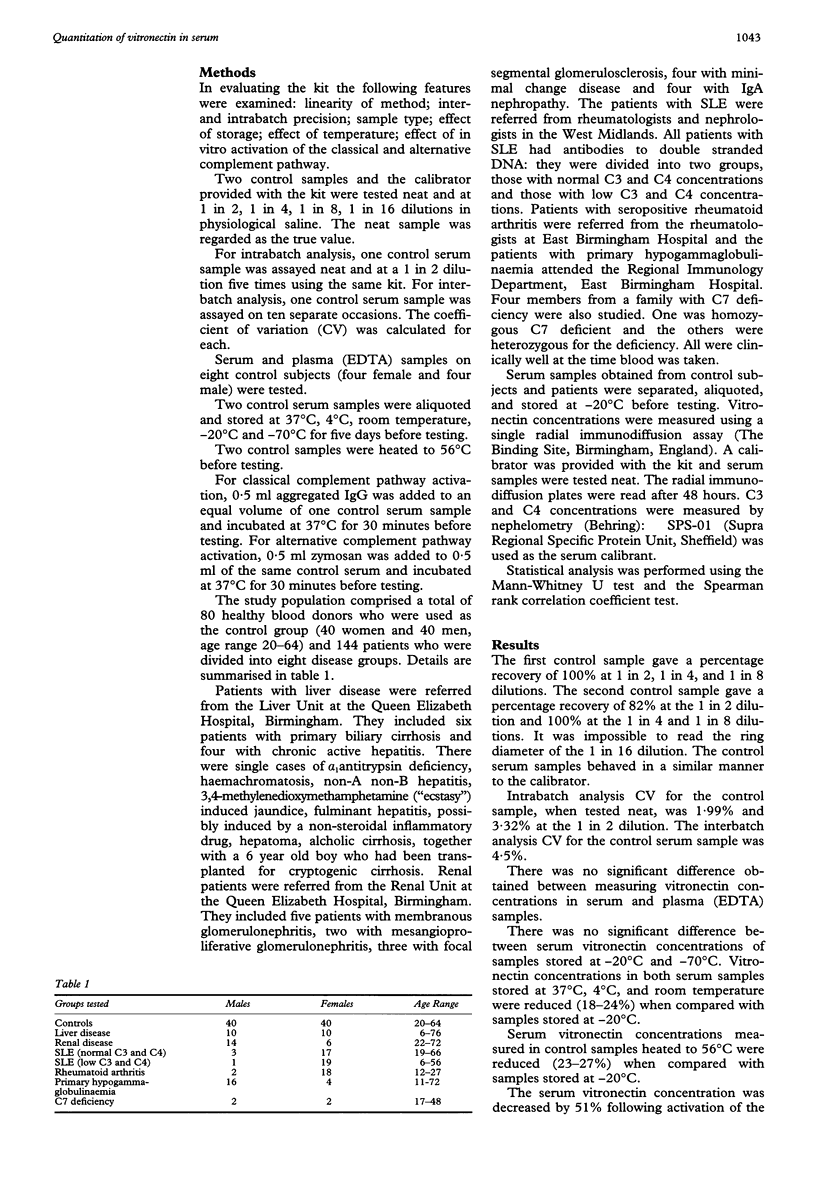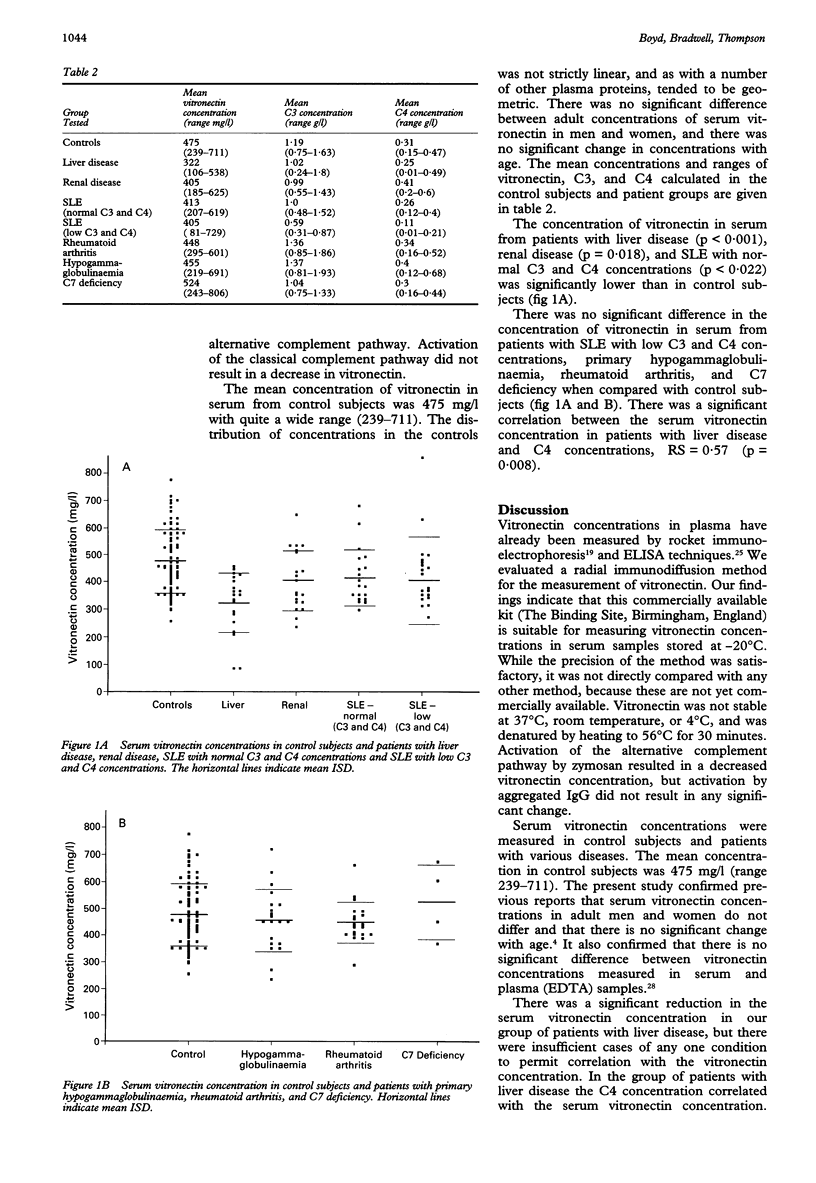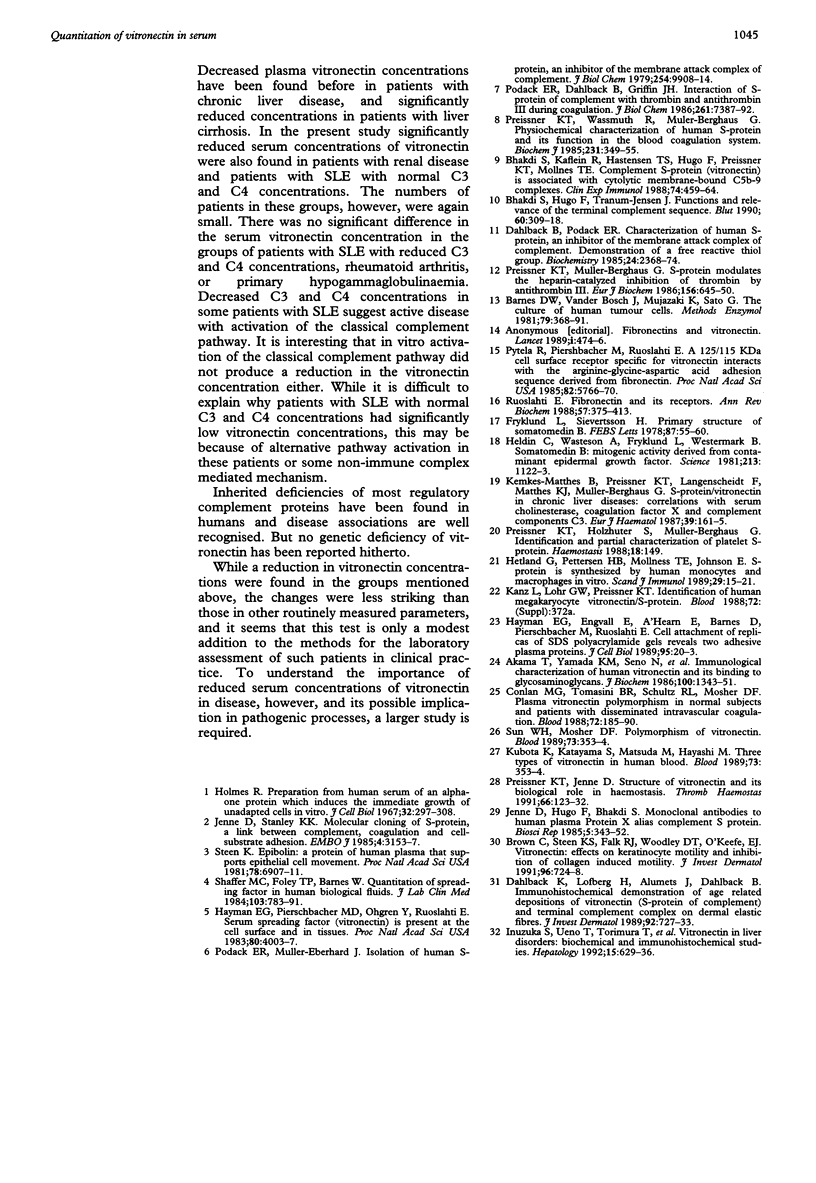Abstract
AIMS--To make a preliminary assessment of the clinical relevance of serum vitronectin concentrations in various disease groups, using a recently available commercial radial immunodiffusion kit. METHODS--Serum vitronectin concentrations were measured in 80 control subjects and 144 patients with various diseases. The following characteristics were used to evaluate the test procedures: linearity of method, inter- and intrabatch precision, effect of storage, temperature and in vitro activation of the classical and alternative complement pathways on vitronectin concentrations. RESULTS--Significantly reduced serum vitronectin concentrations were found in patients with liver disease, renal disease, and systemic lupus erythematosus (SLE) (normal C3 and C4 concentrations, when compared with normal subjects. This particular method was suitable for measuring vitronectin concentrations in serum samples provided they were stored at -20 degrees C. CONCLUSIONS--The clinical value of measuring serum vitronectin seems to be limited, but a larger study may be justified to ascertain the clinical importance of reduced serum vitronectin concentrations in liver diseases, and the possible role of vitronectin in other disease processes.
Full text
PDF



Selected References
These references are in PubMed. This may not be the complete list of references from this article.
- Akama T., Yamada K. M., Seno N., Matsumoto I., Kono I., Kashiwagi H., Funaki T., Hayashi M. Immunological characterization of human vitronectin and its binding to glycosaminoglycans. J Biochem. 1986 Nov;100(5):1343–1351. doi: 10.1093/oxfordjournals.jbchem.a121840. [DOI] [PubMed] [Google Scholar]
- Barnes D., van der Bosch J., Masui H., Miyazaki K., Sato G. The culture of human tumor cells in serum-free medium. Methods Enzymol. 1981;79(Pt B):368–391. doi: 10.1016/s0076-6879(81)79050-5. [DOI] [PubMed] [Google Scholar]
- Bhakdi S., Hugo F., Tranum-Jensen J. Functions and relevance of the terminal complement sequence. Blut. 1990 Jun;60(6):309–318. doi: 10.1007/BF01737843. [DOI] [PubMed] [Google Scholar]
- Bhakdi S., Käflein R., Halstensen T. S., Hugo F., Preissner K. T., Mollnes T. E. Complement S-protein (vitronectin) is associated with cytolytic membrane-bound C5b-9 complexes. Clin Exp Immunol. 1988 Dec;74(3):459–464. [PMC free article] [PubMed] [Google Scholar]
- Conlan M. G., Tomasini B. R., Schultz R. L., Mosher D. F. Plasma vitronectin polymorphism in normal subjects and patients with disseminated intravascular coagulation. Blood. 1988 Jul;72(1):185–190. [PubMed] [Google Scholar]
- Dahlbäck B., Podack E. R. Characterization of human S protein, an inhibitor of the membrane attack complex of complement. Demonstration of a free reactive thiol group. Biochemistry. 1985 Apr 23;24(9):2368–2374. doi: 10.1021/bi00330a036. [DOI] [PubMed] [Google Scholar]
- Dahlbäck K., Löfberg H., Alumets J., Dahlbäck B. Immunohistochemical demonstration of age-related deposition of vitronectin (S-protein of complement) and terminal complement complex on dermal elastic fibers. J Invest Dermatol. 1989 May;92(5):727–733. doi: 10.1111/1523-1747.ep12721619. [DOI] [PubMed] [Google Scholar]
- Fryklund L., Sievertsson H. Primary structure of somatomedin B: a growth hormone-dependent serum factor with protease inhibiting activity. FEBS Lett. 1978 Mar 1;87(1):55–60. doi: 10.1016/0014-5793(78)80132-x. [DOI] [PubMed] [Google Scholar]
- Hayman E. G., Engvall E., A'Hearn E., Barnes D., Pierschbacher M., Ruoslahti E. Cell attachment on replicas of SDS polyacrylamide gels reveals two adhesive plasma proteins. J Cell Biol. 1982 Oct;95(1):20–23. doi: 10.1083/jcb.95.1.20. [DOI] [PMC free article] [PubMed] [Google Scholar]
- Hayman E. G., Pierschbacher M. D., Ohgren Y., Ruoslahti E. Serum spreading factor (vitronectin) is present at the cell surface and in tissues. Proc Natl Acad Sci U S A. 1983 Jul;80(13):4003–4007. doi: 10.1073/pnas.80.13.4003. [DOI] [PMC free article] [PubMed] [Google Scholar]
- Heldin C. H., Wasteson A., Fryklund L., Westermark B. Somatomedin B: mitogenic activity derived from contaminant epidermal growth factor. Science. 1981 Sep 4;213(4512):1122–1123. doi: 10.1126/science.6973821. [DOI] [PubMed] [Google Scholar]
- Hetland G., Pettersen H. B., Mollnes T. E., Johnson E. S-protein is synthesized by human monocytes and macrophages in vitro. Scand J Immunol. 1989 Jan;29(1):15–21. doi: 10.1111/j.1365-3083.1989.tb01094.x. [DOI] [PubMed] [Google Scholar]
- Holmes R. Preparation from human serum of an alpha-one protein which induces the immediate growth of unadapted cells in vitro. J Cell Biol. 1967 Feb;32(2):297–308. doi: 10.1083/jcb.32.2.297. [DOI] [PMC free article] [PubMed] [Google Scholar]
- Inuzuka S., Ueno T., Torimura T., Tamaki S., Sakata R., Sata M., Yoshida H., Tanikawa K. Vitronectin in liver disorders: biochemical and immunohistochemical studies. Hepatology. 1992 Apr;15(4):629–636. doi: 10.1002/hep.1840150413. [DOI] [PubMed] [Google Scholar]
- Jenne D., Hugo F., Bhakdi S. Monoclonal antibodies to human plasma protein X alias complement S-protein. Biosci Rep. 1985 Apr;5(4):343–352. doi: 10.1007/BF01116907. [DOI] [PubMed] [Google Scholar]
- Jenne D., Stanley K. K. Molecular cloning of S-protein, a link between complement, coagulation and cell-substrate adhesion. EMBO J. 1985 Dec 1;4(12):3153–3157. doi: 10.1002/j.1460-2075.1985.tb04058.x. [DOI] [PMC free article] [PubMed] [Google Scholar]
- Kemkes-Matthes B., Preissner K. T., Langenscheidt F., Matthes K. J., Müller-Berghaus G. S protein/vitronectin in chronic liver diseases: correlations with serum cholinesterase, coagulation factor X and complement component C3. Eur J Haematol. 1987 Aug;39(2):161–165. doi: 10.1111/j.1600-0609.1987.tb00747.x. [DOI] [PubMed] [Google Scholar]
- Podack E. R., Dahlbäck B., Griffin J. H. Interaction of S-protein of complement with thrombin and antithrombin III during coagulation. Protection of thrombin by S-protein from antithrombin III inactivation. J Biol Chem. 1986 Jun 5;261(16):7387–7392. [PubMed] [Google Scholar]
- Preissner K. T., Jenne D. Structure of vitronectin and its biological role in haemostasis. Thromb Haemost. 1991 Jul 12;66(1):123–132. [PubMed] [Google Scholar]
- Preissner K. T., Müller-Berghaus G. S protein modulates the heparin-catalyzed inhibition of thrombin by antithrombin III. Evidence for a direct interaction of S protein with heparin. Eur J Biochem. 1986 May 2;156(3):645–650. doi: 10.1111/j.1432-1033.1986.tb09626.x. [DOI] [PubMed] [Google Scholar]
- Preissner K. T., Wassmuth R., Müller-Berghaus G. Physicochemical characterization of human S-protein and its function in the blood coagulation system. Biochem J. 1985 Oct 15;231(2):349–355. doi: 10.1042/bj2310349. [DOI] [PMC free article] [PubMed] [Google Scholar]
- Pytela R., Pierschbacher M. D., Ruoslahti E. A 125/115-kDa cell surface receptor specific for vitronectin interacts with the arginine-glycine-aspartic acid adhesion sequence derived from fibronectin. Proc Natl Acad Sci U S A. 1985 Sep;82(17):5766–5770. doi: 10.1073/pnas.82.17.5766. [DOI] [PMC free article] [PubMed] [Google Scholar]
- Ruoslahti E. Fibronectin and its receptors. Annu Rev Biochem. 1988;57:375–413. doi: 10.1146/annurev.bi.57.070188.002111. [DOI] [PubMed] [Google Scholar]
- Shaffer M. C., Foley T. P., Barnes D. W. Quantitation of spreading factor in human biologic fluids. J Lab Clin Med. 1984 May;103(5):783–791. [PubMed] [Google Scholar]
- Stenn K. S. Epibolin: a protein of human plasma that supports epithelial cell movement. Proc Natl Acad Sci U S A. 1981 Nov;78(11):6907–6911. doi: 10.1073/pnas.78.11.6907. [DOI] [PMC free article] [PubMed] [Google Scholar]
- Sun W. H., Mosher D. F. Polymorphism of vitronectin. Blood. 1989 Jan;73(1):353–354. [PubMed] [Google Scholar]


